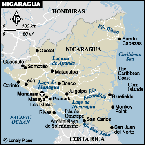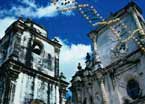 |
 |
||||
|
|
| home | search | help | worldguide | lp shop | thorntree | scoop | travel ticker | theme guides | on the road | postcards | health | subwwway |
|
|
Nicaragua HistoryThe earliest traces of human habitation in Nicaragua are the 10,000-year-old Footprints of the Acahualinca - prints preserved under layers of volcanic ash of people and animals running toward Lago de Managua. Around the 10th century AD, indigenous people from Mexico migrated to Nicaragua's Pacific lowlands, and Aztec culture was adopted by many Indians when Aztecs moved south during the 15th century to establish a trading colony. The first contact with Europeans came in 1502, when Columbus sailed down the Caribbean coast. In 1522, a Spanish exploratory mission reached the southern shores of Lago de Nicaragua. A few years later the Spanish colonized the region and founded the cities of Granada and Len, subduing local tribes. Granada became a comparatively rich colonial city; Len became a hotbed of liberalism. The inhabitants of the heavily populated area around Managua put up a fierce resistance to the Spanish invaders, and their city was destroyed. For the next three centuries Managua was but a village. Nicaragua gained independence from Spain in 1821, along with the rest of Central America. It was part of Mexico for a brief time, then part of the Central American Federation, and finally achieved complete independence in 1838. Soon after, Britain and the USA both became extremely interested in Nicaragua and the strategically important Ro San Juan navigable passage from Lago de Nicaragua to the Caribbean. In 1848, the British seized the port at the mouth of the Ro San Juan on the Caribbean coast and renamed it Greytown. This became a major transit point for hordes of hopefuls looking for the quickest route to Californian gold. In 1855, the liberals of Len invited William Walker, a self-styled filibuster intent on taking over Latin American territory, to help seize power from the conservatives based in Granada. Walker and his band of mercenaries took Granada easily and he proclaimed himself president. He was soon booted out of the country (one of his first moves was to institutionalize slavery) but showed almost absurd tenacity as he repeatedly tried to invade; his efforts set a precedent for continued US interference in Nicaragua's affairs. In 1934, General Somoza, head of the US-trained National Guard, engineered the assassination of liberal opposition rebel Augusto C Sandino and, after fraudulent elections, became president in 1937. Somoza ruled Nicaragua as a dictator for the next 20 years, amassing huge personal wealth and landholdings the size of El Salvador. Although General Somoza was shot dead in 1956, his sons upheld the reign of the Somoza dynasty until 1979. Widespread opposition to the regime had been present for a long time, but it was the devasting earthquake of 1972, and more specifically the way that international aid poured into the pockets of the Somozas while thousands of people suffered and died, that caused opposition to spread among all classes of Nicaraguans. Two groups were set up to counter the regime: the FSLN (Frente Sandinista de Liberacon Nacional, also known as the Sandinistas) and the UDEL, led by Pedro Joaqun Chamorro, publisher of La Prensa, the newspaper critical of the dictatorship. When Chamorro was assassinated in 1978 the people erupted in violence and declared a general strike. The revolt spread and former moderates joined with the FSLN to overthrow the Somoza regime. The Sandinistas marched victoriously into Managua on July 19, 1979. They inherited a poverty-stricken country with high rates of homelessness and illiteracy and insufficient health care. The new government nationalized the lands of the Somozas and established farming cooperatives. They waged a massive education campaign that reduced illiteracy from 50% to 13%, and introduced an immunization program that eliminated polio and reduced infant mortality to a third of the rate it had been before the revolution. It wasn't long before the country encountered serious problems from its 'good neighbor' to the north. The US government, which had supported the Somozas until the end, was alarmed that the Nicaraguans were setting a dangerous example to the region. A successful popular revolution was not what the US government wanted. Three months after Ronald Reagan took office in 1981, the USA announced that it was suspending aid to Nicaragua and allocating US$10 million for the organization of counter-revolutionary groups known as Contras. The Sandinistas responded by using much of the nation's resources to defend themselves against the US-funded insurgency. In 1984, elections were held in which Daniel Ortega, the leader of the Sandinistas, won 67% of the vote, but the USA continued its attacks on Nicaragua. In 1985, the USA imposed a trade embargo that lasted five years and strangled Nicaragua's economy. By this time it was widely known that the USA was funding the Contras, often covertly through the CIA, and Congress passed a number of bills that called for an end to the funding. US support for the Contras continued secretly until the so-called Irangate scandal revealed that the CIA had illegally sold weapons to Iran at inflated prices, and used the profits to fund the Contras. In 1990, Nicaraguans went to the polls and elected Violeta Chamorro, leader of the opposition UNO and widow of martyred La Prensa editor Pedro Chamorro. Chamorro's failure to revive the economy, and her increasing reliance on Sandinista support, led to US threats to withhold aid, but the civil war was over at last. Daniel Ortega ran for president in October 1996, apologizing for Sandinista 'excesses' and calling himself a centrist, but he was defeated by the ex-mayor of Managua, anticommunist Liberal Alliance candidate, Arnoldo Alemn. President Alemn was sworn in January 10, 1997. In November of 1998, Hurricane Mitch trampled the Atlantic coast of Central America, leaving disaster in its wake. The hurricane washed out roads and destroyed bridges throughout the region. In Nicaragua, heavy rains following in the wake of the storm kicked off a mudslide at Volcn Casita that buried several villages. Over 10,000 people died as a result of the hurricane, one of the nastiest this century. The tragedy prompted several nations to cancel Nicaragua's debt in late 1999, and the country is slowly rebuilding. The 2000 mayoral elections saw the Sandinistas gain control of 11 out of 17 departmental capitals, and popular FSLN member Herty Lewites easily won in Managua. However, Liberal Party candidate Enrique Bolanos came out ahead in the presidential election in 2001, beating his Sandinista opponent, former president Ortega. Not giving up on Ortega yet, the Sandinistas renamed him as the party's leader in March 2002. back to top
Disclaimer: We've tried to make the information on this web site as accurate as possible, but it is provided 'as is' and we accept no responsibility for any loss, injury or inconvenience sustained by anyone resulting from this information. You should verify critical information like visas, health and safety, customs, and transportation) with the relevant authorities before you travel. |
 
|
||||||||||||||||||||||||||||||||||||||||
| |
||
home | search | help | upgrades | newsletters | travel services |
||